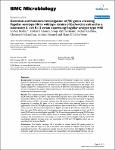Genetical and functional investigation of fliC genes encoding flagellar serotype H4 in wildtype strains of Escherichia coli and in a laboratory E. coli K-12 strain expressing flagellar antigen type H48
Beutin, Lothar
Strauch, Eckhard
Zimmermann, Sonja
Kaulfuss, Stefan
Schaudinn, Christoph
Männel, Andrea
Gelderblom, Hans R.
Background: Serotyping of O-(lipopolysaccharide) and H-(flagellar) antigens is a wideley used method for identification of pathogenic strains and clones of Escherichia coli. At present, 176 O- and 53 H-antigens are described for E. coli which occur in different combinations in the strains. The flagellar antigen H4 is widely present in E. coli strains of different O-serotypes and pathotypes and we have investigated the genetic relationship between H4 encoding fliC genes by PCR, nucleotide sequencing and expression studies. Results: The complete nucleotide sequence of fliC genes present in E. coli reference strains U9-41 (O2:K1:H4) and P12b (O15:H17) was determined and both were found 99.3% (1043 of 1050 nucleotides) identical in their coding sequence. A PCR/RFLP protocol was developed for typing of fliC-H4 strains and 88 E. coli strains reacting with H4 antiserum were investigated. Nucleotide sequencing of complete fliC genes of six E. coli strains which were selected based on serum agglutination titers, fliC-PCR genotyping and reference data revealed 96.6 to 100% identity on the amino acid level. The functional expression of flagellin encoded by fliC-H4 from strain U9-41 and from our strain P12b which is an H4 expressing variant type was investigated in the E. coli K-12 strain JM109 which encodes flagellar type H48. The fliC recombinant plasmid carrying JM109 strains reacted with both H4 and H48 specific antisera whereas JM109 reacted only with the H48 antiserum. By immunoelectron microscopy, we could show that the flagella made by the fliC-H4 recombinant plasmid carrying strain are constituted of H48 and H4 flagellins which are coassembled into functional flagella. Conclusion: The flagellar serotype H4 is encoded by closely related fliC genes present in serologically different types of E. coli strainswhich were isolated at different time periods and geographical locations. Our expression studies show for the first time, that flagellins of different molecular weigth are functionally expressed and coassembled in the same flagellar filament in E. coli.
Dateien zu dieser Publikation
Keine Lizenzangabe
Verwandte Publikationen
Anzeige der Publikationen mit ähnlichem Titel, Autor, Urheber und Thema.
-
2005-06-20ZeitschriftenartikelViral promoters can initiate expression of toxin genes introduced into Escherichia coli Lewin, Astrid; Mayer, Martin; Chusainow, Janet; Jacob, Daniela; Appel, BerndBackground: The expression of recombinant proteins in eukaryotic cells requires the fusion of the coding region to a promoter functional in the eukaryotic cell line. Viral promoters are very often used for this purpose. ...
-
2014-12-04ZeitschriftenartikelLow Rates of Antimicrobial-Resistant Enterobacteriaceae in Wildlife in Taï National Park, Côte d’Ivoire, Surrounded by Villages with High Prevalence of Multiresistant ESBL-Producing Escherichia coli in People and Domestic Animals Albrechtova, Katerina; Papousek, Ivo; Nys, Helene de; Pauly, Maude; Anoh, Etile; Mossoun, Arsene; Dolejska, Monika; Masarikova, Martina; Metzger, Sonya; Couacy-Hymann, Emmanuel; Akoua-Koffi, Chantal; Wittig, Roman M.; Klimes, Jiri; Cizek, Alois; Leendertz, Fabian; Literak, IvanAntimicrobial resistance genes can be found in all ecosystems, including those where antibiotic selective pressure has never been exerted. We investigated resistance genes in a collection of faecal samples of wildlife ...
-
2010-09-29ZeitschriftenartikelPpiD is a player in the network of periplasmic chaperones in Escherichia coli Matern, Yvonne; Barion, Birgitta; Behrens-Kneip, SusanneBackground: The inner membrane-anchored periplasmic folding factor PpiD is described as a parvulin-like peptidyl prolyl isomerase (PPIase) that assists in the maturation of the major beta-barrel outer membrane proteins ...

